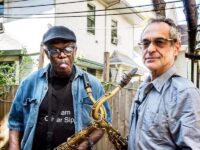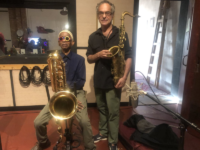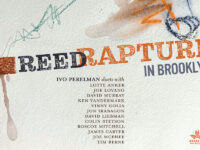Late in 2022, we highlighted some select reed-to-reed duets recorded between tenor saxophonist Ivo Perelman and twelve different noted practitioners of saxophone and sax-like instruments. As we noted then, Reed Rapture In Brooklyn (Mahakala Music) isn’t just another summit meeting of Perelman and some other master improvisor, because this time Perelman chose foils not because of his familiarity with them but for the exact opposite reason.
In case you missed that, Ivo Perelman had at various times over 2021 brought into a Brooklyn studio improvising partners David Liebman, David Murray, Joe Lovano, James Carter, Tim Berne, Roscoe Mitchell, Joe McPhee, Vinny Golia, Jon Irabagon, Ken Vandermark, Colin Stetson and Lotte Anker. And if you know anything about these eleven men and one woman, you know that they are distinctive voices on the saxophone molded from completely different personalities and life experiences.
The story of this project told through these unique recordings is now told through a full-length documentary. Produced and directed by distinguished music film maker Don McGlynn, Reed Rapture In Brooklyn takes us intimately and in real time into the making of Perelman’s wildly ambitious brainchild, a one-of-a-kind 12-CD box set of duet summit meetings with twelve of the foremost living reed players in the world.
Eminent jazz writer Gary Giddins weighs in throughout to provide a wide perspective on the historical importance of these duets, noting that “it’s impossible to distinguish between improvisation and composition and you simply don’t care because it has the integrity of composition even though you felt that they’re just feeling each other out with each moment of the performance.” Joe Lovano later made the observation that what he and Perelman was playing wasn’t “free jazz” but rather, “jazz free,” that is, “improvising as jazz players in a free-flowing manner, creating harmony, creating rhythm, creating the melodies that came through.”
Early on, Perelman’s reveals he has an affliction shared by 4% of world population: synesthesia, whereby he hears music, but sees shapes. Perhaps as a result, Perelman is a visual artist as well as a musical artist, and many of his albums covers are graced with his paintings. The documentary ties together both of his artistic pursuits, showing him creating a new oil-based graphic on the sidewalk side-by-side with him creating on the saxophone in the studio. With these clever juxtapositions, one realizes that his observable abstractions are the physical manifestations of his hearable abstractions; these paintings are merely Ivo’s music art in visual art form.
Even if you’ve heard these recordings already, seeing them do it brings home how well-honed skills conspire with instinct and passion to create vividly candid communion devoid of preconceptions or planning. Watching Perelman play, it is hard not to notice that it doesn’t look like improvising because he never appears to be searching for the next thing to say. He confidently plays the next note with the same demeanor of someone who is playing composed music memorized in advance.
Perelman describes himself as a “chameleon,” able to take on the personality of his counterpoint. And he walks that walk, able to speak in even Colin Stetson’s particularly alien saxophone language. Yet, the chameleon all at once stays in character as well.
Reed Rapture of course puts Perelman at the center of it all, but intentionally or not, it also saves for posterity the artistic essence of every one of his duet partners. The recordings cast each of them in their most unfiltered setting; for some, perhaps in their purest form ever put on record. But further, every one of them in their interviews opened up as to what inspired them, what drives them, what makes them tick as a creating musician. When any of these reed greats leave us, you can pull their segment on this documentary and learn a lot about what they brought to jazz and improvised music and appreciate why they were important for the cause. You witness a great cross-section of real human beings all seizing the opportunity to make music out of the ether with a person they barely knew or did not know at all, because it was the type of challenge they all lived for.
Perhaps the biggest takeaway from the Reed Rapture In Brooklyn documentary is this: that no matter the diverse backgrounds, music made spontaneously is the universal language that they all understand and use speak to each other at the deepest level. Ivo Perelman lives and thrives on this essential truth, and now he provided many of his peers the joy in experiencing those kind of precious moments made immortal by audio recordings and by film.
Reed Rapture In Brooklyn, the documentary, will soon be debuting at film festivals.
- Claudio Scolari Project – ‘Opera 8’ (2024) - April 25, 2024
- Nick Millevoi – ‘Moon Pulses’ (2024) - April 23, 2024
- Cannonball Adderley – ‘Poppin’ in Paris: Live at L’Olympia 1972′ (2024) - April 20, 2024




